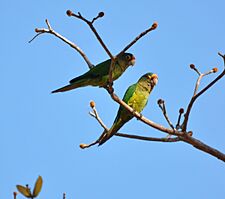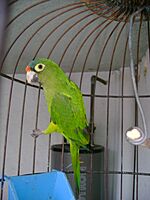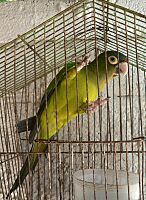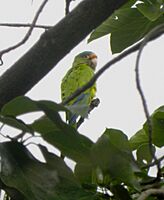Eupsittula canicularis facts for kids
Quick facts for kids Orange-fronted parakeet |
|
|---|---|
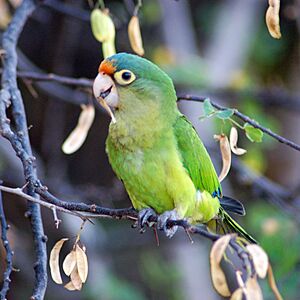 |
|
| In a tree feeding on seeds, Gulf of Papagayo, Costa Rica | |
| Conservation status | |
| Scientific classification | |
| Genus: |
Eupsittula
|
| Species: |
canicularis
|
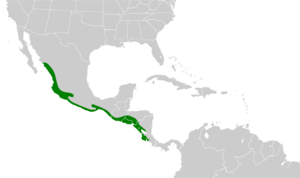 |
|
| Synonyms | |
|
|
The orange-fronted parakeet (scientific name: Eupsittula canicularis) is a colorful bird that lives in Central America. It is also known by other names like the orange-fronted conure, half-moon conure, or Petz's conure. This parakeet is part of the parrot family and is found from western Mexico all the way down to Costa Rica. Sadly, it is considered a Vulnerable species, which means its numbers are decreasing.
Contents
About the Orange-fronted Parakeet
Scientists give every living thing a special two-part name. For this bird, the scientific name is Eupsittula canicularis. This helps scientists around the world know exactly which bird they are talking about. The famous Swedish naturalist Carl Linnaeus first described this parakeet in 1758.
There are three slightly different types, or subspecies, of the orange-fronted parakeet:
- E. c. clarae
- E. c. eburnirostrum
- E. c. canicularis (This is the original type described by Linnaeus.)
What Does the Orange-fronted Parakeet Look Like?
This parakeet is about 23 to 25 centimeters (9 to 10 inches) long. It weighs between 68 and 80 grams (about 2.4 to 2.8 ounces). Both male and female parakeets look very similar.
The most noticeable feature is its bright orange-peach forehead. It also has a dull blue area on the middle of its head. The back of its head and body are a dull green. Around its eyes, there's a ring of bare yellow skin. Its chest is a pale olive-brown, and the rest of its underside is yellowish-green. Its wings are green with bluish flight feathers. Young parakeets look like adults but have less orange on their foreheads.
The different subspecies have small variations:
- E. c. clarae has a very thin orange band on its forehead. Its throat and chest are greener than the main type.
- E. c. eburnirostrum also has a narrow forehead band and is greener underneath.
Where Do Orange-fronted Parakeets Live?
The orange-fronted parakeet lives in different parts of Central America:
- E. c. clarae is found in western Mexico.
- E. c. eburnirostrum lives in southwestern Mexico.
- E. c. canicularis is found along the Pacific coast from southern Mexico through Guatemala, Honduras, El Salvador, and Nicaragua, reaching into northwestern Costa Rica. Some have also been introduced to Puerto Rico.
These parakeets like to live in places that are somewhat open, like the edges of forests, dry woodlands, and savannas. You can also find them in farm areas with scattered trees, like mango and banana plantations. They usually live in lowlands but can be found up to 1500 meters (about 4,900 feet) high.
Behavior and Habits
Movement
When it's not breeding season, orange-fronted parakeets gather in large groups. These groups can have hundreds of birds and travel around to find food. They sometimes fly to higher places during these travels.
Feeding Habits
Orange-fronted parakeets eat a variety of foods. They enjoy fruits, flowers, and seeds from different plants. Sometimes, these large groups of parakeets can eat young corn and ripening bananas, which can be a problem for farmers.
Reproduction and Life Cycle
Orange-fronted parakeets usually nest between January and May in Mexico and El Salvador, and from December to March in Costa Rica. They are very clever about where they build their nests!
They often dig a hole inside the nest of a special type of tree termite. Sometimes, they use natural cracks in trees or holes made by woodpeckers. The female parakeet lays three to five eggs, and she is the one who sits on them to keep them warm. This incubation period lasts about 30 days. The baby parakeets are ready to fly about six weeks after they hatch.
Both the male and female parakeets help dig the nest cavity in the termite mound using their beaks. They work for about a week. After digging, they leave the hole alone for about 7 to 10 days. This gives the termites time to seal off the damaged area and move away. Then, the parakeets return to use the nest.
Vocalization
These parakeets make several different sounds. Their calls include a scratchy, high-pitched keea'ah! and a lower keh'keh'keh'keh'keh. They also have a whining ehhhhh call.
Orange-fronted Parakeets as Pets
The orange-fronted parakeet is sometimes kept as a pet. In the pet world, it's often called the "half-moon conure." These birds are known for being energetic and playful. They love to climb and play. They are generally quieter than some other types of conures and can be friendly if they are socialized well. They are not known for talking a lot, but they might learn a few words or sounds. To stay healthy, pet parakeets need lots of mental activity and time outside their cage to fly.
Conservation Status
The orange-fronted parakeet is currently listed as a Vulnerable species by the IUCN (International Union for Conservation of Nature). This means that its population is decreasing, and it faces a risk of becoming endangered.
There are an estimated half a million to five million adult parakeets left. One of the main threats to these birds is illegal trapping. People sometimes catch them to sell them as pets. While the rate of illegal trapping seems to be slowing down in some areas, it's still a concern. These parakeets can handle some changes to their habitat, but protecting them from trapping is very important for their survival.
Related pages
- Cyanoramphus malherbi, a small parrot commonly known as the orange-fronted parakeet
Gallery
See also
 In Spanish: Perico frente naranjapara niños
In Spanish: Perico frente naranjapara niños



